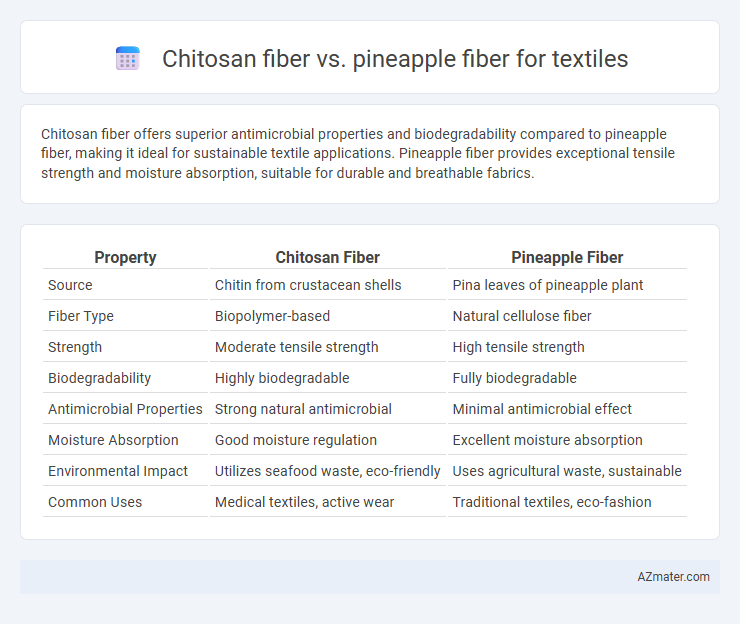Chitosan fiber offers superior antimicrobial properties and biodegradability compared to pineapple fiber, making it ideal for sustainable textile applications. Pineapple fiber provides exceptional tensile strength and moisture absorption, suitable for durable and breathable fabrics.
Table of Comparison
| Property | Chitosan Fiber | Pineapple Fiber |
|---|---|---|
| Source | Chitin from crustacean shells | Pina leaves of pineapple plant |
| Fiber Type | Biopolymer-based | Natural cellulose fiber |
| Strength | Moderate tensile strength | High tensile strength |
| Biodegradability | Highly biodegradable | Fully biodegradable |
| Antimicrobial Properties | Strong natural antimicrobial | Minimal antimicrobial effect |
| Moisture Absorption | Good moisture regulation | Excellent moisture absorption |
| Environmental Impact | Utilizes seafood waste, eco-friendly | Uses agricultural waste, sustainable |
| Common Uses | Medical textiles, active wear | Traditional textiles, eco-fashion |
Introduction to Chitosan and Pineapple Fibers
Chitosan fiber, derived from chitin found in crustacean shells, offers excellent biodegradability, antimicrobial properties, and moisture management, making it suitable for advanced textile applications. Pineapple fiber, extracted from pineapple leaves, provides eco-friendly, strong, and lightweight characteristics, commonly used in sustainable and natural textile production. Both fibers contribute to innovative, renewable textile solutions with unique functional benefits tailored to diverse industry needs.
Sources and Extraction Processes
Chitosan fiber is derived from chitin, primarily sourced from crustacean shells like shrimp and crabs, and extracted through deacetylation involving alkaline treatment, resulting in a biopolymer with antimicrobial properties. Pineapple fiber, also known as Pina fiber, is obtained from the leaves of the pineapple plant using mechanical decortication followed by enzymatic or chemical treatments to separate cellulose fibers. Both fibers emphasize sustainable raw materials but differ significantly in their biological origin and extraction complexity.
Physical and Chemical Properties Comparison
Chitosan fiber exhibits strong antimicrobial properties and excellent moisture retention due to its polycationic nature, making it ideal for medical and hygiene textiles. Pineapple fiber, derived from Ananas comosus leaves, is characterized by high tensile strength, rigidity, and biodegradability, offering durability for eco-friendly fabrics. Chemically, chitosan is composed of deacetylated chitin with reactive amino groups, while pineapple fiber primarily consists of cellulose, lignin, and hemicellulose, influencing their differing moisture absorption and dye affinity properties.
Mechanical Strength and Durability
Chitosan fiber exhibits superior mechanical strength, with tensile strength often ranging between 300 to 500 MPa, making it highly durable for textile applications. Pineapple fiber, though naturally strong with tensile strength approximately 190 to 300 MPa, tends to be more brittle and less resistant to abrasion and environmental degradation. The enhanced durability of chitosan fibers stems from their biopolymeric structure, offering prolonged wear resistance and better performance under stress compared to pineapple fibers.
Moisture Absorption and Breathability
Chitosan fiber exhibits superior moisture absorption due to its hydrophilic nature and excellent moisture-regulating properties, making it highly breathable and comfortable for textile applications. Pineapple fiber, derived from the leaves of the pineapple plant, offers moderate moisture absorption and breathability but excels in durability and tensile strength. In comparison, chitosan fiber provides enhanced moisture management and breathability, ideal for activewear and medical textiles, while pineapple fiber is favored for eco-friendly, robust fabric creation.
Environmental Impact and Sustainability
Chitosan fiber, derived from crustacean shells, offers excellent biodegradability and antimicrobial properties, significantly reducing textile waste and chemical use. Pineapple fiber, sourced from agricultural waste, promotes sustainable farming by repurposing leaves and minimizing deforestation. Both fibers contribute to eco-friendly textiles, yet pineapple fiber often leads in carbon footprint reduction due to its renewable plant origin.
Dyeability and Color Retention
Chitosan fiber exhibits superior dyeability due to its positively charged amino groups, allowing strong interaction with anionic dyes and resulting in vibrant, long-lasting colors. Pineapple fiber, while durable and eco-friendly, has a coarser texture and less affinity for dyes, often requiring pretreatment to enhance color absorption. Chitosan fiber maintains excellent color retention through repeated washing and exposure to light, whereas pineapple fiber may experience fading more rapidly under similar conditions.
Biodegradability and End-of-Life Disposal
Chitosan fiber offers superior biodegradability due to its natural polymer structure derived from chitin, allowing it to decompose rapidly under environmental conditions without leaving harmful residues. Pineapple fiber, sourced from leaves of the Ananas comosus plant, also biodegrades efficiently but at a slower rate compared to chitosan, largely depending on the processing method used. Both fibers contribute positively to sustainable textile end-of-life disposal by reducing landfill impact and facilitating composting or bio-recycling processes.
Textile Applications and Market Trends
Chitosan fiber exhibits excellent moisture absorption, antibacterial properties, and biodegradability, making it ideal for medical textiles, sportswear, and eco-friendly fashion. Pineapple fiber, known for its strength, lightweight nature, and natural luster, is widely used in high-end apparel, upholstery, and sustainable textile products. Market trends show rising demand for both fibers driven by consumer preference for sustainable materials and innovations in bio-based textile manufacturing.
Future Prospects and Research Directions
Chitosan fiber, derived from chitin in crustacean shells, offers exceptional antimicrobial properties and biodegradability, making it a promising candidate for medical textiles and sustainable fashion. Pineapple fiber, extracted from pineapple leaves, is gaining attention for its high tensile strength, eco-friendliness, and potential in high-quality fabric production, especially in the luxury and eco-conscious market segments. Future research aims to enhance the mechanical properties of chitosan fibers and improve processing techniques for pineapple fibers to expand their applications in technical textiles and environmentally sustainable garment manufacturing.

Infographic: Chitosan fiber vs Pineapple fiber for Textile
 azmater.com
azmater.com